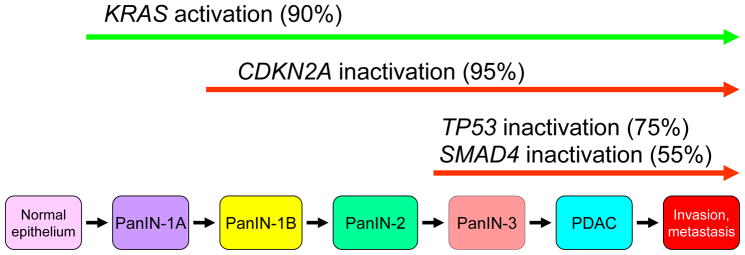Figure 3.

Histologic and genetic progression of pancreatic ductal adenocarcinoma. Pancreatic intraepithelial neoplasias (PanINs), small microscopic abnormal duct structures, are believed to be precursors to invasive pancreatic cancer. While the true precursor cell for PDAC development remains to be fully elucidated, mouse model studies where targeted KRAS activation in acinar cells causes PanIN lesion development suggest that this is the cell of origin for PDAC. The four predominant gene mutations appear to occur in a temporal fashion with PanIN progression. KRAS activating mutations can be found in normal pancreas and PanIN-1. CDKN2A inactivating mutations appear to occur early, in PanINs with low- to intermediate-grade dysplasia, whereas TP53 and SMAD4 inactivating mutations appear to be late events, and occur in PanINs with high-grade dysplasia and in invasive cancer. CDKN2A encodes p14/Arf and p16/Ink4a, an inhibitor of CDK4/6 and G1 cell cycle progression. TP53 encodes the p53 tumor suppressor, a regulator of the cell cycle that is responsible for maintaining cellular and genetic stability. SMAD4 encodes Smad4, a downstream component of the TGF-β signaling network. Oncogenes are indicated with green arrows and tumor suppressors with red arrows.
